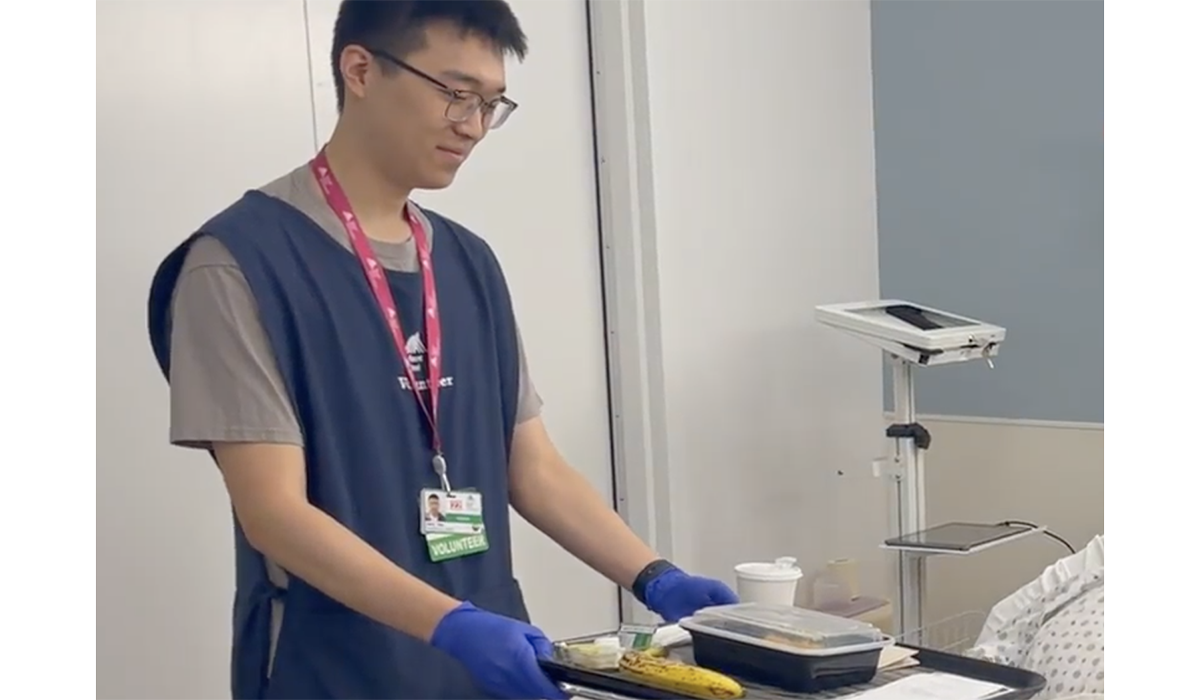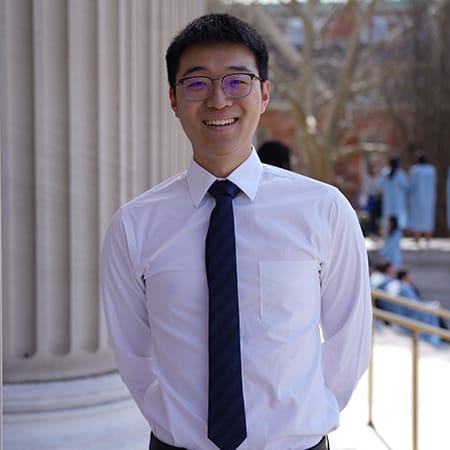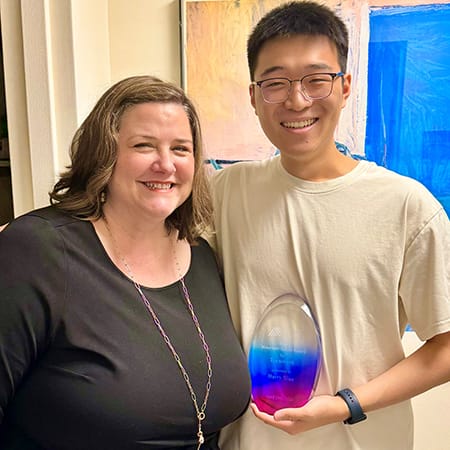College Student Enhances Emergency Patients’ Hospital Experience

Meet Daily Point of Light Award honoree Harry Xiao. Read his story, and nominate an outstanding volunteer or family as a Daily Point of Light.
Harry was born in California, but moved to China at six years old and completed most of his schooling there before eventually returning to the States to attend college. Harry recently graduated from Columbia University, where he obtained a degree in biomedical engineering. Beyond his studies, Harry enjoys playing tennis and joining fantasy sports leagues with friends. In college, Harry developed an interest in research and worked at a lab where he focused on new treatments for pancreatic cancer. Harry’s focus on biomedicine, however, also led to a strong passion for the hospital volunteer work he pursued.
In our healthcare system, there is often a tug-of-war between the patients’ needs and the ability of nurses and doctors to meet those needs. Due to heavy workloads, nursing staff and doctors are often only able to focus on patients’ clinical needs, such as assessing pain levels and diagnostic testing. However, medical staff aren’t able to see patients for as long as patients want to be seen, and they don’t have the time to offer the necessary level of emotional support.
This is by no means to say that healthcare providers don’t care. They do; and they care a lot. However, they are overwhelmed with a heavy workload. This leads to tension between patients and providers, and often an unpleasant hospital experience.
Harry understood the vital role volunteers could play in helping patients and alleviating healthcare providers’ workloads. If a volunteer could sit with a patient, providing companionship and a caring face, all while addressing their basic needs such as adjusting pillows, getting them a warm blanket or giving them some snacks and a drink, a patient’s experience would dramatically improve.
Harry took on this volunteer role in the Emergency Department of Mount Sinai Morningside. He was also instrumental in resurrecting the Meal Assistance Volunteer Program (MAP) at the hospital. The program focuses on ensuring patients with limitations when trying to feed themselves still receive nutritious meals. For example, these patients may have limited dexterity or may be unable to use their arm(s). MAP aims to alleviate malnutrition, but it’s also a way for patients to have much needed social interaction and to have their emotional needs met during their hospital stay.

What inspires you to volunteer?
My interest in biomedicine developed as a result of personal health challenges and hospital experiences. Many of my own healthcare providers put in a lot of effort for me and this sparked my interest in volunteering. I wanted to find a way to support the healthcare community that helped me. It’s incredibly difficult for doctors and nurses to attend to individual patients because they see so many patients every day. Once I started volunteering, I saw things from both the patient’s and the provider’s point of view. It’s evident that both the nurses and patients need support, and I feel that volunteering is a direct way to meet that need of lightening the load for healthcare providers, and ensuring a better experience for patients.
Nurses are incredibly busy, often juggling six or more patients at once. When they have to sit with a patient who has limited mobility and can’t feed themselves, it’s easy to become frustrated at the amount of time this requires — time that takes them away from caring for the patient’s other needs, as well as their other patients.
I was working with the palliative care team who brought up the idea that a MAP program would be very helpful to them. I took the lead on bringing this program back to Mount Sinai Morningside. Today, in its current form, it’s so much more than feeding patients who can’t feed themselves.
Tell us about your volunteer role with Mount Sinai Morningside.
To launch the MAP program, I filmed and created MAP training materials in collaboration with several departments throughout the hospital. I have put together a training program that includes important information about how to feed patients safely, the importance of nutrition and demonstration videos. I am also currently recruiting volunteers for the program.
In addition to the MAP program, I work with patients in the Emergency Department where my focus is providing comfort support. In fact, working with the Emergency Department was my first volunteer role at Mount Sinai.
On one hand, I assist nursing staff with non-clinical time-consuming duties including preparing new beds, bringing in supplies and taking samples to the lab. Beyond helping nurses, I engage with patients. I talk to them to learn about and help resolve their current needs and challenges. People are often alone for extended periods and may become hungry, thirsty or uncomfortable, but the nursing staff doesn’t always have time to attend to their needs.
Patients also need someone to talk to, especially those who are at the hospital alone. They’re often stressed in the hectic emergency department, and just being there for them helps alleviate some of the tension they feel. I provide companionship when they may not have anyone with them.
Volunteers are not allowed to do anything clinical. The doctors and nurses are occupied with the clinical aspect of patient care which leaves little time for emotional support; this is where we volunteers step in, with a focus on making the patient experience better.
What are your long-term volunteering plans?
I am moving from New York to California this summer, so I won’t be able to participate as a volunteer in the Mount Sinai Morningside Emergency Department anymore. However, I plan to continue working virtually with Amy Bush, our director of Volunteer Services, on the MAP program. I would like to see many if not most of the volunteers at Mount Sinai Morningside be trained in MAP, which means more volunteers would be able to step in and help at any given time.
I also hope to expand the program to other Mount Sinai locations. With more development and streamlining of the training, we could send the program to other hospitals within the Mount Sinai system to expand the impact and benefits of the MAP program.
Once I am in California, I hope to become involved in hospital volunteering as well. I plan on working in a research laboratory and eventually pursuing advanced degree studies.
What’s been the most rewarding part of your work?
Getting to see firsthand how I can make a terrible experience better for the patients has been incredibly rewarding. People in emergency rooms are scared, anxious, in pain and often frustrated by the slowness of attention. Being there when they need something as small as a juice or a blanket is a small gesture that is so meaningful to them.
I love getting to sit with them and seeing them open up. I did a rotation with the palliative care team where I accompanied a terminally ill cancer patient in his room for several hours. We chatted in Mandarin, his native language, which he had not used since arriving at the hospital. The effect was immediate. He felt a sense of cultural familiarity and understood that someone cared. I learned about him, we shared our lives and stories and he could shift his focus to something other than being in a hospital. His favorite food was even the same as mine! After I left, some of the nurses on the unit said that he had the biggest smile they had ever seen on his face. I like to think that my companionship was comforting to him, and that is incredibly rewarding.

What have you learned through your experiences as a volunteer?
All of us have the ability to improve someone’s day. Listening to people and being humble about the interaction is enough to learn how you can help them and how you can advocate for them. It’s so important to advocate for these vulnerable people who are alone in the emergency room, who might struggle to ask a nurse or doctor for help and who aren’t able to voice their concerns and challenges. This is the first step in making a better experience for them.
Any advice for people who want to start volunteering?
There are always people in need, and many don’t have much support. This is of course true in healthcare, but also everywhere else. There are always opportunities to help people. If you’re interested in volunteering, go for it and don’t be afraid to speak up when you think you can help. Speak up in support of the communities you care about, and lend your time, energy and talents to create the changes you hope to see.
What do you want people to learn from your story?
We can be difference makers in the lives of people who are vulnerable. While you provide comfort and support to these people, you also learn about yourself. As a volunteer, you will work with a diverse group of people. In the Emergency Department, I’ve seen patients across the entire socio-economic spectrum. For all their differences though, they’re all connected by the same urgent need of medical help. That creates a very interesting perspective, to think about how the very different backgrounds and life experiences of these individuals affect how they are responding to their situation and hospital stay. By being humble and open-minded towards the people you’re helping, you can take lessons from what you learn about and from them, and apply them, to your life. There is so much room for personal growth in volunteering.
Do you want to make a difference in your community like Harry? Find local volunteer opportunities.